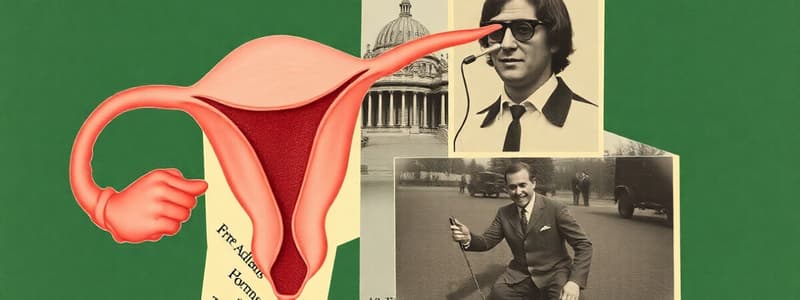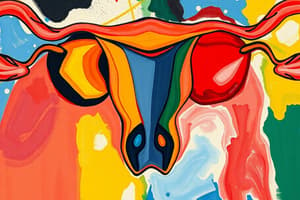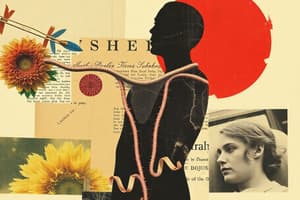Podcast
Questions and Answers
Considering the varied reproductive strategies in the animal kingdom, which of the following scenarios would most likely require a complex interplay of hormonal regulation, precise anatomical adaptations, and behavioral cues to maximize reproductive success?
Considering the varied reproductive strategies in the animal kingdom, which of the following scenarios would most likely require a complex interplay of hormonal regulation, precise anatomical adaptations, and behavioral cues to maximize reproductive success?
- A flatworm species capable of both sexual reproduction and regeneration through fragmentation.
- A population of stony corals releasing gametes into the water column for external fertilization.
- A mammal species inhabiting a resource-scarce environment exhibiting delayed implantation and facultative adjustment of offspring sex ratios. (correct)
- A species of jellyfish undergoing asexual reproduction via budding in a stable marine environment.
In species exhibiting ovoviviparity, the exclusive source of nutrition for the developing embryo is derived directly from the mother's bloodstream via a placental connection, analogous to that observed in viviparous organisms.
In species exhibiting ovoviviparity, the exclusive source of nutrition for the developing embryo is derived directly from the mother's bloodstream via a placental connection, analogous to that observed in viviparous organisms.
False (B)
Describe the evolutionary trade-offs that might lead a species to favor asexual reproduction over sexual reproduction, particularly in a highly dynamic and unpredictable environment.
Describe the evolutionary trade-offs that might lead a species to favor asexual reproduction over sexual reproduction, particularly in a highly dynamic and unpredictable environment.
Asexual reproduction allows for rapid population growth when conditions are favorable, but limits genetic diversity, potentially hindering adaptation to changing environments.
The phenomenon of ________ in kangaroos exemplifies a reproductive strategy that optimizes offspring survival by allowing the temporary suspension of embryonic development in response to adverse environmental conditions.
The phenomenon of ________ in kangaroos exemplifies a reproductive strategy that optimizes offspring survival by allowing the temporary suspension of embryonic development in response to adverse environmental conditions.
Match each component of the male reproductive system with its primary function during sperm production, maturation, and delivery:
Match each component of the male reproductive system with its primary function during sperm production, maturation, and delivery:
Which of the following hormonal interactions best characterizes the transition from proestrus to estrus in a polyestrous mammal, assuming optimal nutritional status and absence of environmental stressors?
Which of the following hormonal interactions best characterizes the transition from proestrus to estrus in a polyestrous mammal, assuming optimal nutritional status and absence of environmental stressors?
While artificial insemination effectively bypasses natural mating behaviors, it completely eliminates any potential influence of maternal-fetal interactions on offspring phenotype and long-term health outcomes.
While artificial insemination effectively bypasses natural mating behaviors, it completely eliminates any potential influence of maternal-fetal interactions on offspring phenotype and long-term health outcomes.
Elaborate on the potential selective pressures that might favor the evolution of seasonal estrous cycles in certain mammalian species inhabiting temperate or polar regions.
Elaborate on the potential selective pressures that might favor the evolution of seasonal estrous cycles in certain mammalian species inhabiting temperate or polar regions.
The practice of using a ________ in swine artificial insemination aids in assessing receptivity by observing vocalizations and vulvar secretions, crucial indicators of optimal timing for insemination.
The practice of using a ________ in swine artificial insemination aids in assessing receptivity by observing vocalizations and vulvar secretions, crucial indicators of optimal timing for insemination.
Match each species with the characteristic type of uterus they possess:
Match each species with the characteristic type of uterus they possess:
In the context of species with bipartite or bicornuate uteri, what biomechanical advantage do elongated uterine horns confer during gestation, especially when considering litter size and fetal development?
In the context of species with bipartite or bicornuate uteri, what biomechanical advantage do elongated uterine horns confer during gestation, especially when considering litter size and fetal development?
The sole determinant of the duration of gestation in mammals is the absolute size of the neonate at birth, with larger offspring invariably requiring longer in-utero developmental periods.
The sole determinant of the duration of gestation in mammals is the absolute size of the neonate at birth, with larger offspring invariably requiring longer in-utero developmental periods.
Contrast the physiological and behavioral indicators of impending parturition in a primiparous mare versus those observed in a multiparous sow, highlighting species-specific adaptations.
Contrast the physiological and behavioral indicators of impending parturition in a primiparous mare versus those observed in a multiparous sow, highlighting species-specific adaptations.
During the pre-farrowing stage in swine, the enlargement of ________ serves as a key visual indicator of approaching parturition, reflecting increased mammary gland development in preparation for lactation.
During the pre-farrowing stage in swine, the enlargement of ________ serves as a key visual indicator of approaching parturition, reflecting increased mammary gland development in preparation for lactation.
Relate each stage of farrowing in swine to its dominant physiological events:
Relate each stage of farrowing in swine to its dominant physiological events:
A researcher is investigating the reproductive strategies of a newly discovered species of amphibian that inhabits a highly variable aquatic environment. Which combination of reproductive traits would MOST effectively buffer the species against extinction in the face of unpredictable environmental fluctuations?
A researcher is investigating the reproductive strategies of a newly discovered species of amphibian that inhabits a highly variable aquatic environment. Which combination of reproductive traits would MOST effectively buffer the species against extinction in the face of unpredictable environmental fluctuations?
The primary function of relaxin is to stimulate uterine contractions during parturition, ensuring the efficient expulsion of the fetus from the birth canal.
The primary function of relaxin is to stimulate uterine contractions during parturition, ensuring the efficient expulsion of the fetus from the birth canal.
Describe the potential consequences of administering exogenous estrogen to a female mammal during late gestation, considering the known effects of estrogen on uterine contractility and cervical dilation.
Describe the potential consequences of administering exogenous estrogen to a female mammal during late gestation, considering the known effects of estrogen on uterine contractility and cervical dilation.
The estrous cycle determines when a female is receptive to ______ (heat period).
The estrous cycle determines when a female is receptive to ______ (heat period).
Connect each hormone with its primary role in female reproduction:
Connect each hormone with its primary role in female reproduction:
Flashcards
Reproduction
Reproduction
A biological process where new organisms are produced from their parent(s).
Asexual Reproduction
Asexual Reproduction
Parents produce genetically identical offspring.
Sexual Reproduction
Sexual Reproduction
Involves two parents (male and female) contributing genetic material.
Oviparous
Oviparous
Signup and view all the flashcards
Viviparous
Viviparous
Signup and view all the flashcards
Ovoviviparous
Ovoviviparous
Signup and view all the flashcards
Hormones
Hormones
Signup and view all the flashcards
Testosterone
Testosterone
Signup and view all the flashcards
Estrogen
Estrogen
Signup and view all the flashcards
Progesterone
Progesterone
Signup and view all the flashcards
Relaxin
Relaxin
Signup and view all the flashcards
Oxytocin
Oxytocin
Signup and view all the flashcards
Testicles
Testicles
Signup and view all the flashcards
Epididymis
Epididymis
Signup and view all the flashcards
Scrotum
Scrotum
Signup and view all the flashcards
Vas Deferens
Vas Deferens
Signup and view all the flashcards
Urethra
Urethra
Signup and view all the flashcards
Penis
Penis
Signup and view all the flashcards
Ovaries
Ovaries
Signup and view all the flashcards
Oviducts
Oviducts
Signup and view all the flashcards
Study Notes
- Reproduction is a biological process where new organisms are produced from parents.
Two Forms of Reproduction:
- Asexual reproduction involves one parent producing genetically identical offspring, examples include jellyfish and sea sponges
- Sexual reproduction involves two parents, male and female
Types of Sexual Reproduction:
- Oviparous animals bear offspring by laying eggs (e.g., birds, fish, insects, frogs)
- Viviparous animals give birth to live young, common in almost every mammal species (e.g., cats, dogs, elephants)
- Ovoviviparous animals have eggs that develop inside the mother's body, where the yolk feeds the young until birth (e.g., snakes, sharks)
Hormones:
- Hormones are chemical messengers produced by endocrine glands that control metabolic processes in animals
Male Hormones:
- Testosterone is critical for sperm development
Female Hormones:
- Estrogen is critical for follicle development
- Progesterone sustains pregnancy and inhibits new follicle development
- Relaxin causes ligaments around the birth canal to relax
- Oxytocin causes milk letdown
Male Reproductive System:
- Testicles are the site of sperm production and testosterone synthesis, sperm contains 1/2 of the genetic makeup
- Epididymis stores and matures sperm
- The scrotum protects the testes and regulates temperature
- Vas Deferens transports sperm from the epididymis to the urethra
- The urethra is a tube inside the penis that transports sperm or urine
- The penis is the organ of copulation
Female Reproductive System:
- Ovaries produce eggs that contain 1/2 of the genetic makeup
- Oviducts are the site of fertilization and transport embryos to the uterus
- The uterus is the site of embryonic development during gestation
- The cervix connects the uterus and vagina and serves as a barrier during pregnancy
- The vagina is the female organ of copulation during mating and an opening of the bladder
- The vulva is the external opening of the reproductive system
Different Female Reproductive Systems:
- Advanced Duplex (Opossum), have two uteri, cervices, and vaginas, allows carrying multiple pregnancies at different stages
- Opossums are marsupial mammals and give birth to very underdeveloped young which crawl into a pouch to develop
- Kangaroos also have a duplex reproductive system and practice embryonic diapause, where they can pause embryo development if conditions are unfavorable
- Duplex (Rabbit, Mouse), have 2 uteri and 2 cervices
- Rabbits are induced ovulators, ovulating only when mating occurs, leading to their reputation for rapid reproduction, a single rabbit can give birth to (4-12) kits in one litter and multiple pregnancies per year
- Mice and rats produce large litters quickly (6-12 pups every 3 weeks!)
- Bicornuate (Pig, Dogs):
- Pigs have a highly developed bicornuate uterus with long uterine horns, enabling large litters of 10-14 piglets per pregnancy
- Dogs also have a bicornuate uterus, the size of the litter depends on the breed, and the spacing of embryos reduces competition for nutrients
- Bipartite (Sheep, Goats), have a bipartite uterus
- Sheep allow for one or two lambs per pregnancy and have unique scent and sound
- Goats adapt for one or two kids per pregnancy
- Modified Bipartite (Horses, Rhinoceroses)
- Horses have a modified bipartite uterus, ensuring well-developed foals
- Rhinos have modified bipartite uterus the gestation period can last 15-16 months
- Simplex (Humans, Gorillas):
- Humans have a simplex uterus designed for carrying one baby though twins can occur
- Gorillas also have a simplex uterus designed for single births and gestation lasts 8.5 months
Events of Reproduction:
- Puberty is when reproductive organs become functional
- Cattle: 6 to 12 Months
- Sheep: 5 to 7 Months
- Swine: 4 to 8 Months
- Horses: 12 to 15 Months
- Humans: 9 to 16 Years
- Females undergo a reproductive process
Estrous Cycle:
- Repetitive cycle occurring when pregnancy does not
- It determines when a female is receptive to mating
- Polyestrous (Cattle, Swine) exhibits a cycle all year-round
- Seasonal Estrous (Sheep, Horses) depends on daylight changes
- Estrus or "Heat" refers to receptivity to mating
Estrous Cycle Length:
- Cattle: 19 to 23 Days
- Sheep: 14 to 19 Days
- Swine: 19 to 23 Days
- Horses: 10 to 37 Days
Estrus Cycle Duration:
- Cattle: 12 to 18 Hours
- Sheep: 24 to 36 Hours
- Swine: 48 to 72 Hours
- Horses: 3 to 8 Days
Signs of Estrus:
- Swollen vulva
- Mucous discharge
- Restless behavior
- Female receptivity to male
Specific Signs of Estrus:
- Cattle: Visually active mounting
- Sheep: Few external signs
- Swine: Brace with pressure to back, vocal grunting
- Horses: Tease with Stallion and will go nose to nose
Fertilization:
- Egg and sperm unite
- The male contributes the sperm
Male Transfer of Sperm:
- Can occur naturally with male and female engaging or via artificial insemination (AI)
- AI Pros:
- Conception rate is high
- Extends use of superior males
- One ejaculate can fertilize many females
- Reduces venereal diseases
- Provides individual straw per female
- Improves record keeping
- Can accelerate genetic improvements
- AI Cons:
- Requires knowledge of the estrus cycle
- Cost intensive
- Requires payment for AI
- AI Use in Farm Animals:
- Dairy Cattle: widely used
- Beef Cattle: limited use
- Sheep: limited use
- Swine: intermediate use
- Horses: restricted by breed associations
Basic AI Process:
- Check for heat
- Assemble tools
- Clean tools and exterior surface
- Perform AI and record information
How Animal AI Processes Differ:
- Cattle: Follow cervix through anus, guiding the pipette
- Sheep: Use microscope to guide pipette
- Swine: Out of body guiding of pipette
- Horses: Restricted by breed
Swine AI Process:
- Check for heat using a teaser bore, listening for vocal cues, and observing the swollen vulva
- Apply back pressure, keep arms tight, and note ear flapping
- Use lubricant, insert the catheter, push it in about 4-6 inches, and move forward until resistance is felt
- Rotate and feel for pressure, connect the semen, and gently squeeze whilst resisting the rush
- After a five-count, rotate and pull out
- Record important information, and check it didn't leak out
Length of Gestation:
- Length of time of pregnancy
- Cattle: 283 - 285 Days
- Sheep: 147 Days
- Swine: 114 Days
- Horses: 336 Days
Parturition:
- Act of giving birth
- Cattle: Calving
- Sheep: Lambing
- Swine: Farrowing
- Horses: Foaling
Signs of Parturition:
- Distended abdomen
- Mammary development and milk secretion
- Swollen vulva and relaxed pelvic ligaments
- Mucous discharge
- Relentlessness and separation from group
- Labor and Contractions
- Appearance of placental membrane
- Expulsion of fetus
- Bonding behavior
The Farrowing Process:
- Stage 1: Pre-Farrowing
- Lasts 10-14 days
- Signs:
- Mammary gland development and vulva swelling
- Teat enlargement and prominent udder veins
- Reduced appetite and restlessness
- Milk secretion
- Mucous discharge
- Cervix opens
- Stage 2: Farrowing
- Lasts 3-8 hours
- Piglets born every 10-20 minutes
- Signs of imminent birth:
- Sow lies on her side, shivers, and lifts a back leg
- Tail twitching
- Stage 3: Post-Farrowing
- Lasts 1-4 hours
- The placenta is expelled
- Signs farrowing is complete:
- Sow is calm and interacts with piglets
- Shivering and leg movement stop
- Post farrowing discharge occurs for 3-5 days
Studying That Suits You
Use AI to generate personalized quizzes and flashcards to suit your learning preferences.



